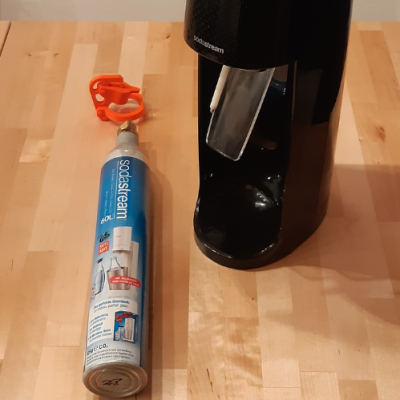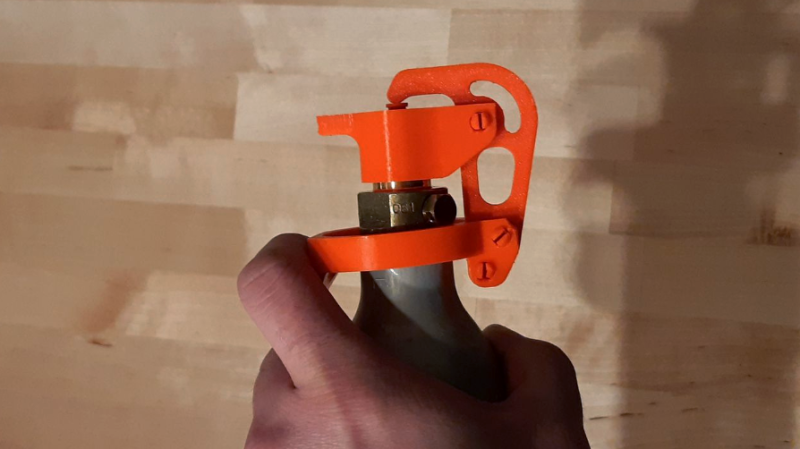 Soda Stream machines use a cylinder of compressed CO2 to carbonate beverages, and cylinders that are “empty” for the machine’s purposes in fact still have a small amount of gas left in them. User [Graldur] shared a clever design for using up those last gasps from a cylinder by turning it into a makeshift compressed air gun, the kind that can blow crumbs or dust out of inconvenient spots like the inside of a keyboard. It’s 3D printed in PETG with a single seal printed in Ninjaflex.
Soda Stream machines use a cylinder of compressed CO2 to carbonate beverages, and cylinders that are “empty” for the machine’s purposes in fact still have a small amount of gas left in them. User [Graldur] shared a clever design for using up those last gasps from a cylinder by turning it into a makeshift compressed air gun, the kind that can blow crumbs or dust out of inconvenient spots like the inside of a keyboard. It’s 3D printed in PETG with a single seal printed in Ninjaflex.
[Graldur]’s 3D printed assembly screws onto the top of an “empty” cylinder and when the bottom ring is depressed like a trigger, the valve is opened slightly and the escaping gas is diverted through a narrow hole in the front. As a result, it can be used just as you would a can of compressed air. The gas outlet even accommodates the narrow plastic tubes from WD-40 cans (or disposable compressed air cans, for that matter) if more precision is required.
The design is intended for use with nearly-empty cylinders, but even so, [Graldur] also points out that it has been designed such that it can never fully actuate the cylinder’s release valve no matter how hard one presses, so don’t modify things carelessly. We also notice the design keeps the user’s hand and fingers well away from the business end of things.
This device also reminds of somewhat of a past experiment which used 3D printing to create serviceable (albeit low pressure) 3D printed compressed air tanks in custom shapes.
















Use a full bottle and turn it upside down for eve more fun!
And do it in a confined space with no ventilation for bonus points
If there’s no ventilation, you’re already screwed. If there’s no ventilation and you do this, it increases the pressure, but doesn’t affect the total amount of O2, so you might breathe a bit harder to get it, but it’s still gonna keep you alive about as long. Unless you lie down, then you might be in a CO2 blanket. The time to worry would be if there’s ventilation above shoulder height, say in a basement, or in the hull of a boat, and you manage to displace all breathable air upwards out of your reach with it.
You only get about 3 seconds of thrust, then it just starts sputtering dry ice chunks, that was one Sunday afternoons hope of a rocket man suit dashed when I was 11. :-(
Or refill it with scuba tank compressor.
Don’t do this! CO2 (which is what these bottles are designed for) stores at around 750-850PSI. SCUBA compressors fill tanks to 3000PSI.. Now you’ll probably just pop a burst disk, but that’s still pretty bad as the cylinder will be full of gas. CO2 stores as a liquid, so you only get a short pulse of gas if a burst disk ruptures, then it slowly boils off..
This would be an improvement over using “canned air” for a freeze spray and getting that bitterant all over your repair piece and tools and hands.
The anti-huffer stuff is a real hoot when you handle your screwdrivers a month later, not thinking about that bittereant being all over them and thus forgetting to wear disposable gloves.
It will survive a thorough handwashing, including cleaning under your nails.
Makes for loads of fun trying remove your contact lenses, that it has contaminated, after rubbing your eyes and they’ve slimed over like a snail in salt.
https://en.wikipedia.org/wiki/Denatonium
There are the mini versions used to fill push bike tires. Could be interesting. Perhaps a propellant for a cube sat. Give one a good push with a gyro to stabilise it and you could put something on the moon. Maybe a transmitter made from a musical birthday card on a loop so it’s a bit like Sputnik. A kind of annoying repetitive, I did this.
Compessed air is not a toy. Much more dangerous than liquid CO2. IMHO the whole idea is pretty stupid to try and even more to publish like being a “clever idea”.
Hug
Neither is a lot of the projects based on High Voltages like Tesla Coils, Nixie Tubes, Electroluminescent displays, etc.
Take some personal responsibility for your own safety, if you don’t feel safe with compressed air, then don’t use it.
This whole modern attitude towards safety is atrocious, NO ONE ELSE should be responsible for YOUR safety because it leads to complacency.
the HV projects you listed are usually low power (unless you’re willing to burn the money for a properly sized Tesla coil), poor example…think MOTs as a starting point and keep adding.
Compressed air is dangerous because people fail to realize just how much power will be released if the pressure vessel fails.
If the pressure vessel is big enough, unlike the HV projects, they will endanger others. There are many pictures on the web of pressure cylinders (or parts of them) that drove themselves through a wall (or the poor sod messing with them). Liquified gasses need energy to boil off, compressed will all go at once.
I distinctly remember seeing the aftermath of a SCUBA tank compressor hose failing. Because of a safety valve, only the air that was in the hose connecting went loose. Still was enough to throw windows out out of their frames on that shed.
Just like steel squished in a press, compressed air is a spring. It needs respect.
How is compressed air not a toy?
I like Whipp-Its.
Whipp-its are N2O, very simillar thermodynamics to CO2 and stored as a liquid.
We were always taught in mechanical engineering school to treat pressurized vessels as a bomb. That point ws literally beaten into our heads. The ASME came about due to boiler pressure vessels exploding, killing people. Be careful. A 3d printed part that is brittle due to filament layering is even more worrisome.
Compressed air, CO2 or whatever, are not toys. Pretty ignorant, or even clueless, to publish this as a hack.